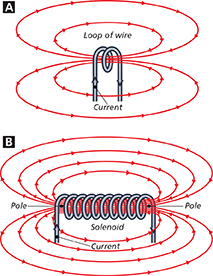Quick Lab
Making an Electromagnet
Materials
iron nail, 20 small metal paper clips, 20-cm length and 1-m length of insulated wire with stripped ends, 6-volt battery, switch
Procedure 
Make a circuit using the nail, wire, battery, and switch. Use the shorter wire to connect one terminal of the battery to the switch. Connect the longer wire to the other terminal of the battery. Wrap this wire around the nail 10 times. Then connect the longer wire to the switch.
Hold the head of the nail over the pile of paper clips. Close the switch. Record how many paper clips the nail can pick up.
Open the switch. CAUTION If the switch is left closed, the wire will become very warm. Wrap the longer wire 40 more times around the nail in the same direction as before.
Close the switch. Record how many paper clips the nail can pick up now.
Open the switch and disconnect the circuit.
Analyze and Conclude
Observing How did your ability to pick up paper clips with the nail change when you increased the number of turns in the coil?
Drawing Conclusions Why did the nail become a magnet when a current-carrying wire was wrapped around it?
Solenoids and Electromagnets A
Before you can use electromagnetic force, you need to be able to control it. Using electromagnetic force requires some simple tools. Figure 9A shows a current-carrying wire with a loop in it. The magnetic field in the center of the loop points right to left through the loop, as shown in Figure 9A.
Suppose you loop the wire many times to make a coil, as shown in Figure 9B. Then the magnetic fields of the loops combine so that the coiled wire acts like a bar magnet. The field through the center of the coil is the sum of the fields B from each turn of the wire. A coil of current-carrying wire that produces a magnetic field is called a solenoid.
If you place a ferromagnetic material, such as an iron rod, inside the coil of a solenoid, the strength of the magnetic field increases. The magnetic field produced by the current causes the iron rod inside the coil of the solenoid to become a magnet. An electromagnet is a solenoid with a ferromagnetic core.  Changing the current in an electromagnet controls the strength and direction of its magnetic field. You can also use the current to turn the magnetic field on and off. People use many devices every day, such as hair dryers, telephones, and doorbells, that utilize electromagnets.
Changing the current in an electromagnet controls the strength and direction of its magnetic field. You can also use the current to turn the magnetic field on and off. People use many devices every day, such as hair dryers, telephones, and doorbells, that utilize electromagnets.
Figure 9 The magnetic field lines around a solenoid are like those of a bar magnet. Applying Concepts Which of the poles is north?
 d
d



